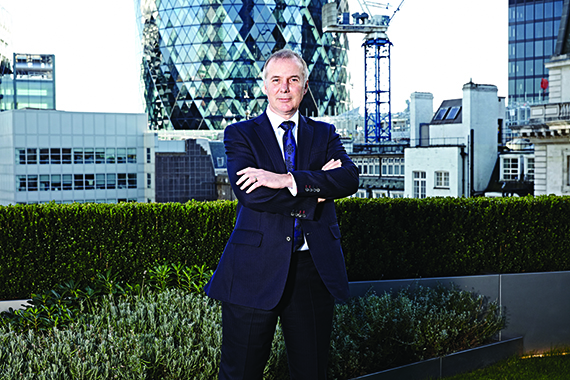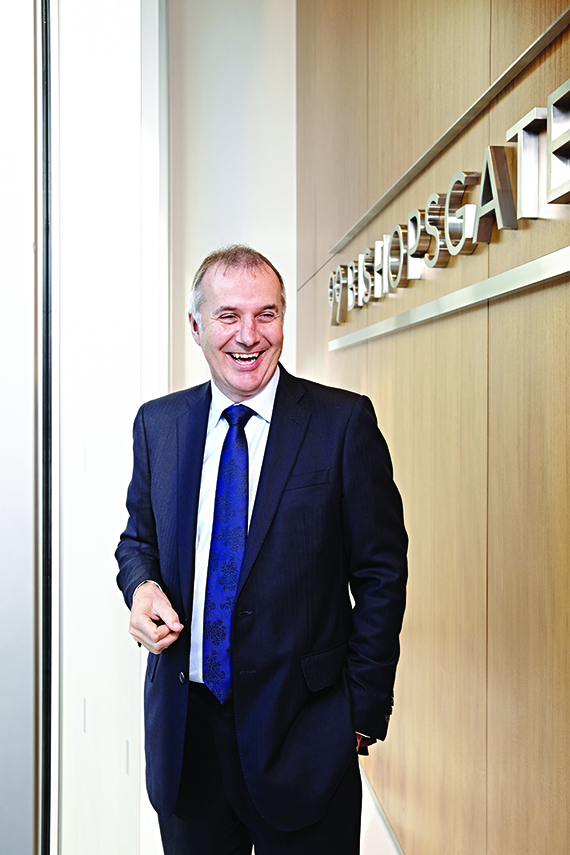Martin Jepson is keeping schtum. He refuses to divulge how much Brookfield paid for each of the assets when it bought the bulk of Hammerson’s London office business in June 2012.
And without breaking down how each of the three large offices, the Principal Place development site and a handful of smaller ownerships were valued, it is hard to pin down precisely how the £518m deal has performed.
But consider this: in the two-and-a-half years since the portfolio changed hands, City yields have compressed by around 100 basis points. Then factor in that Brookfield has let more than 1m sq ft across the portfolio.
That’s when you start to get an inkling of just how good a deal this has been. So good that even Jepson, Brookfield’s vice president for Europe, admits that “it sounds slightly arrogant”, as he bats off another attempt to worm out more detail on how much was paid for each of the component parts.
“I think the headline is that we are well above our returns on each individual property and, therefore, obviously combined as a portfolio, performance has been well above expectations,” he says.
The fact that Jepson may not wish to shout about precisely how much value has been created will be of little comfort to Hammerson’s shareholders. The reason behind the sale of the portfolio was the result of a strategic decision by the REIT to become a retail specialist, a move designed to create better returns for its investors.
In light of the returns that Brookfield now appears to be achieving, Hammerson has come in for a pasting from some City commentators. Mike Prew, managing director at Jefferies, believes the deal has “gone against Hammerson, big time”.
After Blackstone’s smash-and-grab raid of British Land’s Broadgate jewels, is this another example of how UK REITs have been on the wrong side of the best deals during the cycle?
The ground work
North American asset manager Brookfield arrived in London in 2010 when it entered a joint venture with Great Portland Estates, giving it a 50% stake in the 900,000 sq ft 100 Bishopsgate development, EC3.
Jepson was still at Hammerson at the time and the deal was led by Brookfield’s head of global property, Ric Clark.
“Having made the joint venture with GPE to develop 100 Bishopsgate, Ric made it clear that he wanted to find a London platform,” says GM Real Estate founder Tony Gibbon, who advised GPE on the jv and then Brookfield on the Hammerson purchase.
With retail man David Atkins having taken over as chief executive of Hammerson in 2009, questions arose around whether the idea of REIT specialisation – abandoned by Land Securities during the crisis in 2008 – could be back on the agenda.
Brookfield made an initial approach to Hammerson regarding a potential jv. That deal didn’t happen, but neither was it immediately rebuffed.
In July 2011 when Hammerson announced London boss Jepson was leaving the business to pursue new opportunities, Brookfield hired him, well aware of his unrivalled knowledge of the platform it coveted.
“Having identified Hammerson, [Ric Clark] had real conviction to get a transaction done and to put together a team that could execute its business plan,” says Gibbon.
The deal
At the start of 2012 Hammerson confirmed it wanted to sell its London business, prompted by a story in the Times.
Several other bidders came out of the woodwork including LandSec – which wanted to trade its stake in Bristol shopping centre Cabot Circus for some of the London developments – and Oxford Properties.
But Brookfield got its deal, after executing due diligence with remarkable speed, agreeing to pay £189m for Leadenhall Court, EC3, and a half stake in 125 Old Broad Street, EC2, and £329m for 99 Bishopsgate, EC2, the Principal Place development site and a couple of neighbouring buildings, plus an interest in the complex lease structure of the Puddle Dock site, EC4.
A couple of weeks later Hammerson allowed its development option agreement with the City of London for the 500,000 sq ft London Wall Place, EC3, scheme to expire, stating the development did not meet its return requirements.
Brookfield stepped in and, for £20m, secured a new option from the City for the site, in a joint venture with Oxford Properties.
“[David] Atkins said that Hammerson had decided to focus on retail assets because they generated higher returns than London offices, which was right, up until then,” Prew wrote in an analyst note earlier this autumn. “But the past isn’t always an accurate guide to the future.”
With the second phase of the deal finally completed in June 2013, Brookfield immediately set about proving there was value to be had in the City.
The aftermath
Its first significant deal was in July 2013, when it sold a stake in the residential element of the Principal Place, EC2, scheme, a 50-storey Foster+Partners-designed tower to be built next to the proposed 600,000 sq ft office block.
Based on Estates Gazette’s estimates, Principal Place represented about £50m of the total portfolio price, a figure Jepson declines to comment on. After 12 months of soaring residential values, a jv agreement with Concord Pacific went a long way to recouping this cost, meaning Brookfield was left with a massive office development for which it had paid very little.
This summer Amazon agreed to prelet 430,000 sq ft of the development, with options on the other 170,000 sq ft, which expire in phases up until the anticipated completion in 2017.
The agreed rent was not disclosed but the price quoted to prospective tenants was £50 per sq ft.
That means the office development could have a rent roll of around £30m. Once complete, and assuming a relatively conservative 5% yield, it could be valued at £550m. Take out the £250m it will cost to build and Brookfield will be sitting on a substantial profit.
As well as preletting at least 70% of Principal Place, Amazon also signed a short-term deal at Leadenhall Court, agreeing to rent the entire 108,000 sq ft building from Brookfield at least until Principal Place is complete, but with the option to stay there longer. Long-term, Jepson says Brookfield may look to develop a tower on the Leadenhall site, with Ken Shuttleworth’s Make Architects appointed earlier this year to see what may be possible.
The other big letting Brookfield has secured was to Schroders, which prelet all 310,000 sq ft of One London Wall Place at the end of last year. With US law firm Cleary Gottleib now under offer for around 60,000 sq ft in Two London Wall Place, Brookfield and Oxford Properties are circa 75% prelet across the 500,000 sq ft development.
With rents at London Wall over £60 per sq ft, the final rent roll of the building will be in excess of £30m, implying a GDV of more than £550m against development costs of around £150m.
There have been less headline-grabbing lettings too. At 99 Bishopsgate, 100,000 sq ft of vacancy has been let at rents of £50 per sq ft in the podium and more on the upper floors, while at 125 Old Broad Street almost 40,000 sq ft of vacant space was filled.
This has allowed Brookfield to take advantage of an investment market that has also been moving in its favour.
The original half-stake in 125 Old Broad Street was acquired together with Leadenhall Court for £189m, suggesting it cost something like £130m. Brookfield then bought in the other half of the building in late 2013. Given the way the market moved, the second 50% cost the company more like £140m. Jepson won’t comment on the figures, but he is happy to confirm that the eventual sale of the building in July this year to Blackstone, for £320m, crystallised a “considerable” profit for Brookfield – around £50m, according to Estates Gazette’s estimates.
The returns
So how well has the deal performed for Brookfield?
“Brookfield has probably extracted north of £1bn pre-financing costs,” Prew concluded in a note on the merits of REIT specialisation earlier this autumn.
Either way, for Brookfield the decision to pounce on the City of London has been more than vindicated.
Which raises the question about what the company does next. Its debut London deal – 100 Bishopsgate – is now its only site that is not committed.
GPE assembled the site before entering a jv with Brookfield in 2010, a decision it made because the scheme was too large for a company of its size to pursue on its own.
With a brimming West End development pipeline, GPE then sold down a further 37.5% stake in the scheme in October 2012. The deal put Brookfield in control, allowing it to call the shots on how much of the scheme should be prelet before construction could start. At that point its appetite for risk was tempered by the fact it was sitting on 2m sq ft of unlet City development – around half of the total pipeline in the Square Mile.
Chief executive Toby Courtauld said: “We didn’t sell out entirely then because we wanted some effective hedging against that prelet materialising, with the hope that they would prelet the building.”
However, last month GPE did exercise its right to exit entirely, selling its final 12.5% stake for £15.7m.
That decision could be read in one of two ways. Either GPE believes there is little prospect of a prelet kicking the scheme off any time soon. Or, as now seems more likely given the lack of space available in the City, because Brookfield is looking to get going on the scheme with a less substantial level of prelet than GPE feels comfortable with.
While Jepson is clear Brookfield would never speculatively build such a large development, the company’s early success in the City is clearly increasing its appetite for risk.
Normally, says Jepson, a 40% prelet would be enough to justify kicking off such a major scheme. But instead of looking at each development in isolation, Jepson says Brookfield will assess its appetite for risk across the entire portfolio.
“I think it’s the one building where we may be a little bit more flexible,” he says.
So will 100 Bishopsgate be the next big City tower to come out of the ground, ahead of rivals like the Scalpel, the Pinnacle, Gotham City or the Can of Ham?
“I would hope so,” says Jepson. “I think frankly my task – and this is probably putting my neck on the block now – is to make sure that it is.”













